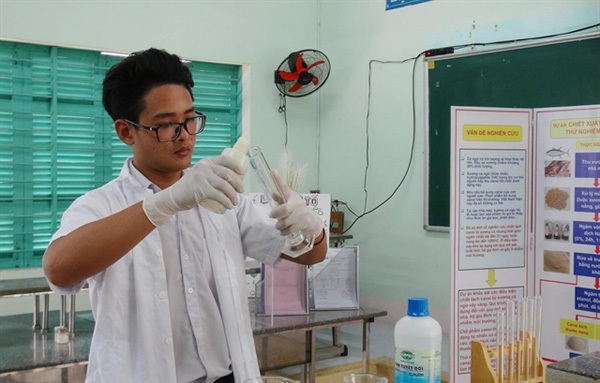
A high-school student has discovered a simple way of extracting calcium from tuna bones. Trinh Hoang Long hopes his method to collect the calcium can be used as a good source of nutrition.
 |
| Trinh Hoang Long working in laboratory. |
A high-school student has discovered a simple way of extracting calcium from tuna bones.
Trinh Hoang Long hopes his method to collect the calcium can be used as a good source of nutrition.
The 12th grader, who lives in Nha Trang City, knows there is an abundance of tuna in the central coastal province of Khanh Hoa.
So he decided to try and find a way of utilising the wasted bones from the fish.
“I knew that Khanh Hoa Province has extremely rich marine resources, including tuna with large reserves of 600,000 tonnes,” said Long.
Although the bones contain high levels of calcium in the form of hydroxyapatite, right now they are only being used to produce fertiliser and feed for cattle and poultry.
During two years, the student had surveyed the conditions for extracting calcium from tuna bones by chemical hydrolysis at appropriate concentrations to obtain natural calcium preparations with fairly high purity or nanoscale.
“Tuna bones were finely washed, cooked, dried up and soaked in solutions of NaOH for 24 hours at 90 degrees Celsius,” Long said.
“Then the bones were washed and dried up again and finely ground into powder.
“The final stage was to soak the ground bones in ethanol for five minutes and wait for the powder settle for 24 hours. In the end, I obtained micro and nano preparations of calcium.”
The finished calcium could be added to daily used foods to provide extra nutrition.
Controlling the right temperature and proportion was the most important element of the extracting process because if mistakes were made, it would be difficult to remove the calcium.
Before Long’s method, there were some other studies to extract calcium from fish bones by different ways.
Typically, they were hydrolysis with NaOH chemicals at high temperature and calcination.
However, both of these methods were difficult to perform outside laboratories and factories due to the use of high temperatures of between 250-1,200 degrees Celsius needed.
Long’s method required just 90 degrees Celsius so it was easy to apply in practice.
“My method was so simple that anyone could extract calcium from tune bones at home to take advantage of waste from seafood processing plants,” Long said.
School support
During the project, Long received support from family, friends and Nguyen Van Troi High School.
His school provided him with money to buy materials for experiments as well as contacting Nha Trang University to let him use their lab for tests.
“The school’s facilities were too modest to meet the requirements of scientific research so I had to ask the help from universities in the city,” said Huynh Vinh Khang, the principal of Nguyen Van Troi High School.
“Long is a student good at chemistry and biology so he easily accessed the fish bone hydrolysis method for calcium extraction,” Khang said.
His achievement was a testament to Long and teachers’ efforts in implementing and developing scientific research movement in school, the principal said.
The extraction of calcium from tuna bones which is used as a nutrition supplement was simple.
However, to use the calcium extraction in medicine and pharmaceutical fields, more research needed to be done, Long said.
Long plans to study subjects relating bio-technology to develop his project in the future.
“I wish all people can be able to extract calcium from tuna bone by themselves to use it as a nutrition supplement for the family and avoid wasting the available source of calcium as well,” Long said.
His work has already won a prize in the Science and Technology Contest for High School Students organised by the Ministry of Education and Training in June in Da Nang City.
(Source: VNS)





